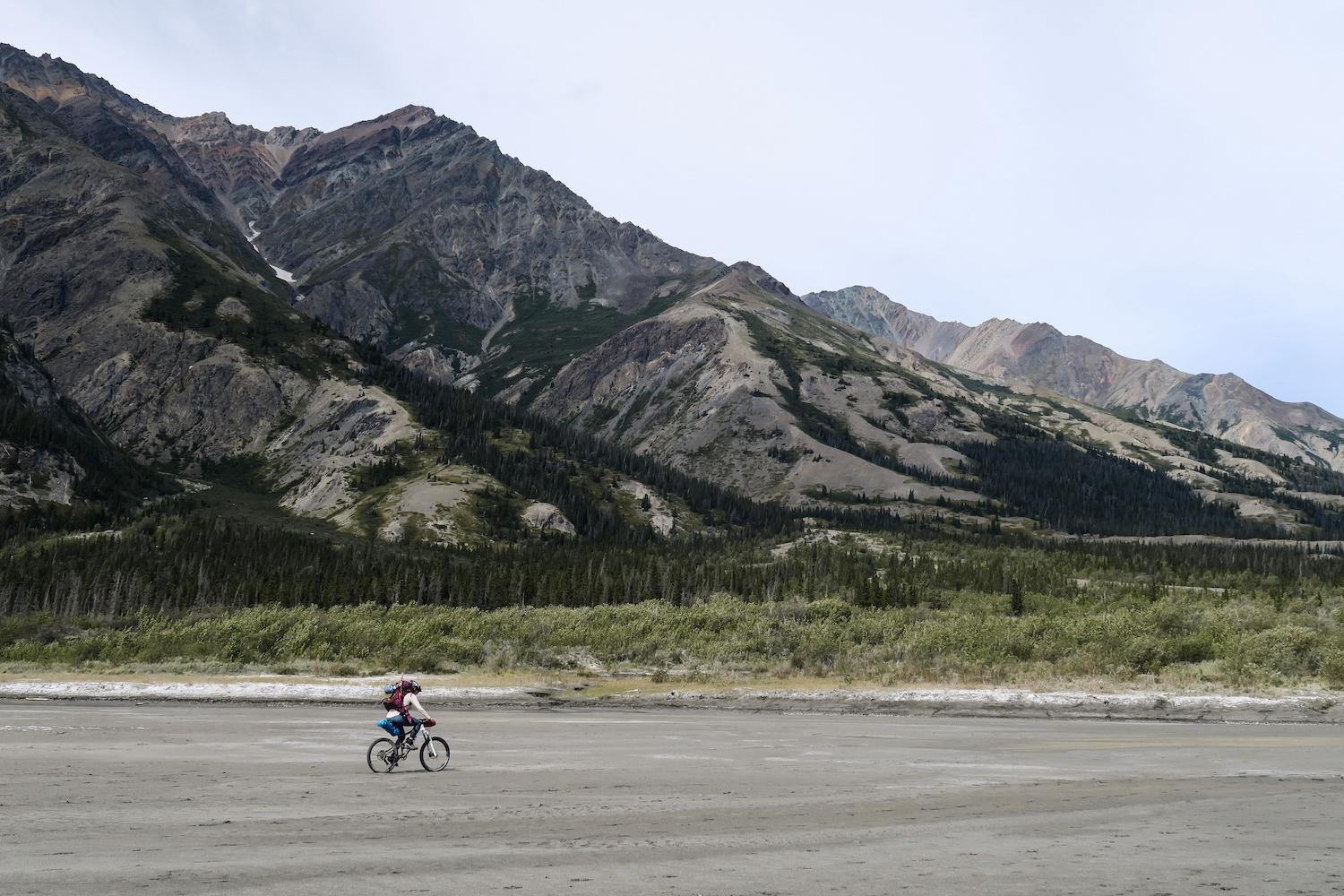
Cycling Ä’äy Chù and its dried floodplain in Kluane/Rachel Bertsch
When Yukon Rivers Run Dry
By Rachel Bertsch
It only took a matter of days for the Slims River, Ä’äy Chù in Southern Tutchone, to reduce from a large glacial river to a mere stream amongst a dusty plain. Four days to be exact. News swirled around the world as yet another sad confirmation of human caused climate change.
The change was so quick that by the time we heard about it and left our home in Whitehorse, Yukon, just two hours away from the river valley, we were too late to see any semblance of river left.
It was dubbed an act of "river piracy," a geomorphological stream capture event in which one river is rerouted into another river and, in this case, changing drainage systems and watersheds completely. It was 2016 and was the first modern documented case that researchers were able to witness.
In Kluane National Park and Reserve, Christine Aikens, part of the Yukon Field Unit with Parks Canada, couldn't estimate which rivers or glaciers were likely next to disappear. But if the past has anything to tell us, it doesn’t look promising. “In the last 50 years, the area glaciated has decreased by 20 per cent and over 230 small glaciers have disappeared.”
Home to 17 of the 20 tallest mountains in Canada (including Mount Logan at 19,551 feet), 80 per cent of Kluane is covered in glacial ice, with more than 2,000 glaciers, some over half a mile deep. The front ranges are home to sharp canyons and rushing rivers that gather in turquoise lakes, glimmering beneath what feels like an untouched wilderness.
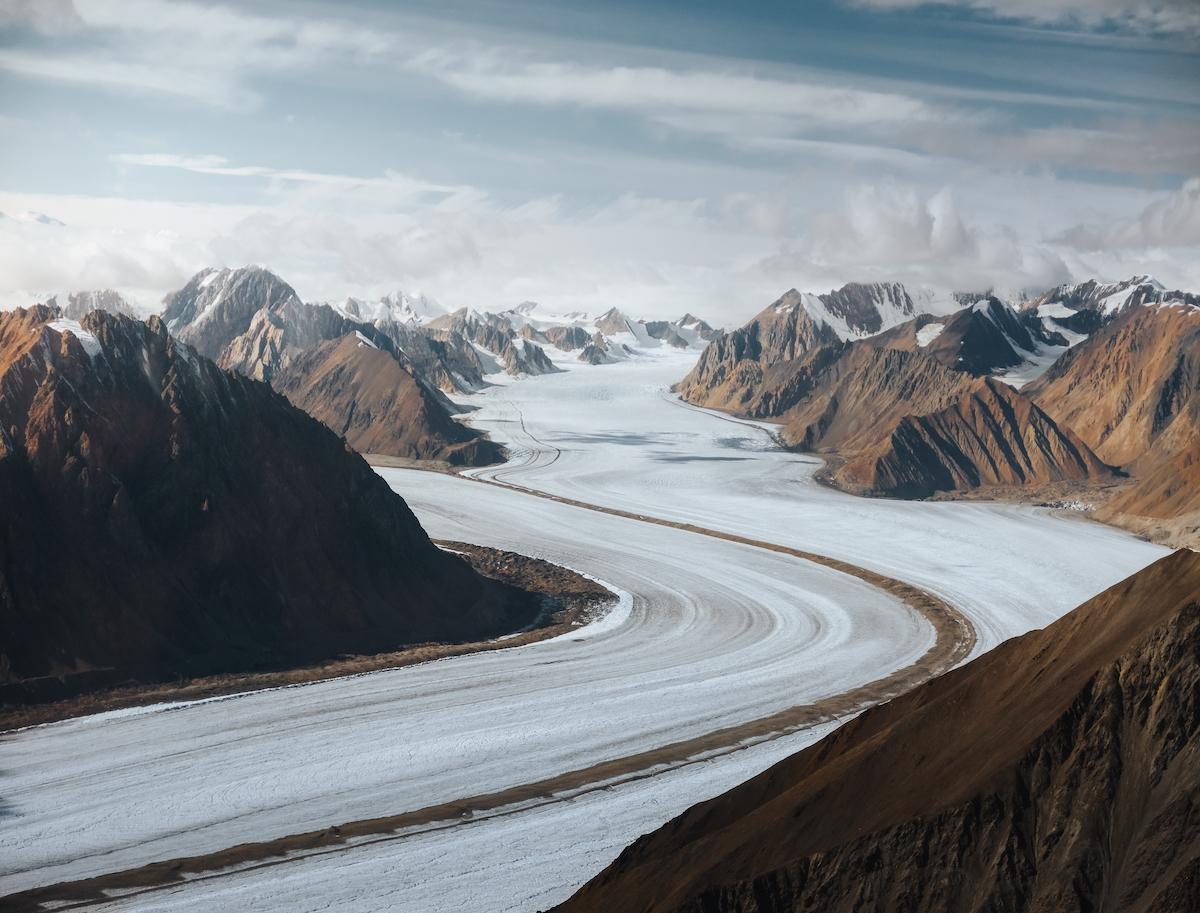
A dramatic view of Kaskawulsh Glacier in Kluane/Victor Aerden, Travel Yukon
The fate of Ä’äy Chù was sealed when the Kaskawulsh glacier receded enough that its meltwaters changed directions towards the steeper Kaskawulsh River that empties into the Pacific rather than the Arctic watershed.
Overnight, the floodplain of braided silty channels became a trickle dribbling across a barren valley floor. Once exposed, fine sediments carried by katabatic winds blasted through the valley. Dust storms became common and air quality began to plummet.
In the five years since the river vanished, we’ve made numerous trips to Ä’äy Chù as the towers of rock often draped in snow that enclose the valley are impossibly beautiful.
I first laid eyes on Kluane after following the ribbon of concrete that bisects the wilderness and clings to the eastern perimeter of the Saint Elias Mountains in Yukon. Kluane sits on the northeastern quarter of the world’s largest internationally protected land, an UNESCO World Heritage Site with Glacier Bay National Park & Preserve, Wrangell-St. Elias National Park & Preserve, and Tatshenshini-Alsek Provincial Park.
Our introduction was memorable. Strolls to rock glaciers perched above lake trout and burbot bearing lakes. Walks along sub-alpine trails above the boreal spruce and pine forests, up to alpine flowers in glacial cirques. One hundred and twenty miles of trail is dispersed across nearly 100 miles of road and every turn is scenic.
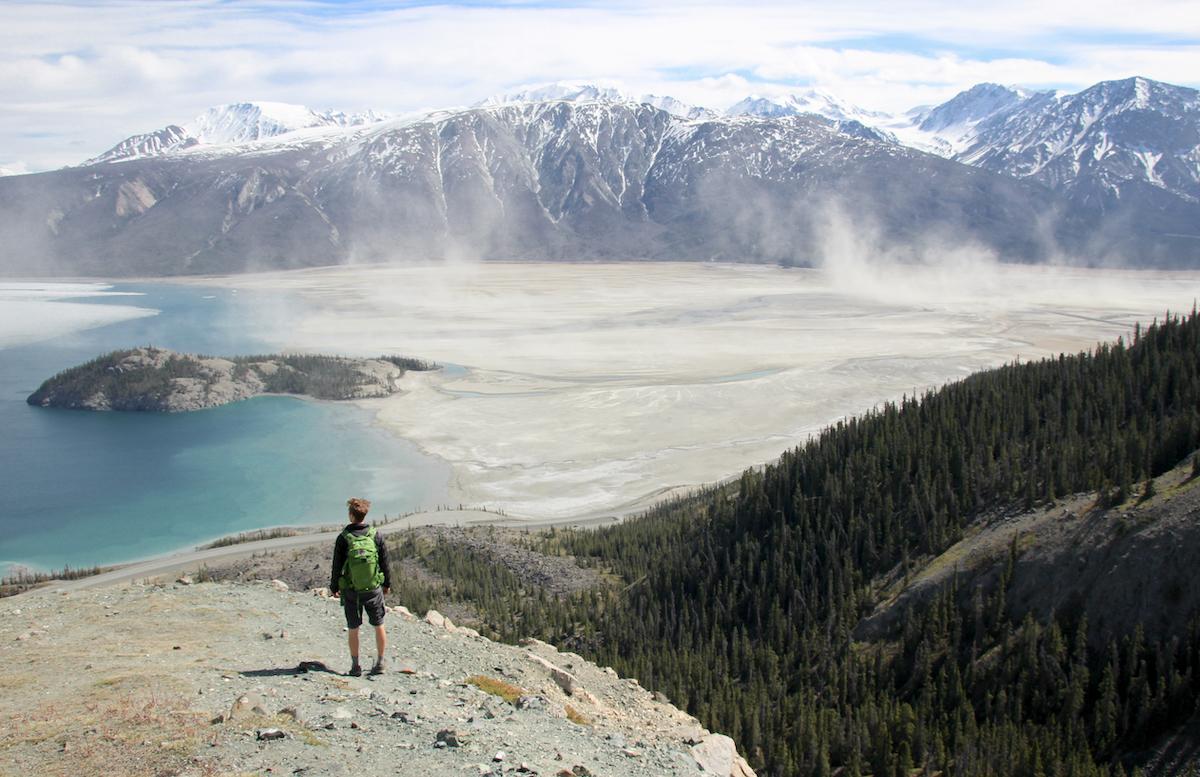
A 2017 view of the ’Ä’äy Chù dried out floodplain and a spring dust storm/Rachel Bertsch
At Ä’äy Chù, a humble secondary visitor centre sits above the floodplain with an extraordinary 360-degree view. It is easily accessed via the two-lane Alaska Highway. No longer just a patchwork of corduroy roads winding through the boreal forest, the Alaska Highway has been smoothed out since its 1942 inception. Highway visitors going to and from Alaska make up the largest percentage of the roughly 53,000 annual visitors (as of 2019) to Kluane according to the management plan which aimed to promote the park with more day use opportunities that showcased “a spectacular Canadian landscape of high mountain peaks, massive valley glaciers, boreal forests, northern wildlife, and rich cultural heritage.”
Ä’äy Chù is a must-see for those highway travelers which ticks all those boxes. In the summer months the Thechàl Dhâl Visitor Centre hosts interpretive programs and sets a telescope lens on visible herds of Dall sheep that roam the mountain.
The humbling scale of the landscape has inspired countless generations.
Thousands of years ago, the Southern Tutchone people took refuge amongst the mountains and the mountains, animals, and seasons have been integral to their cultural way of life. Sadly in 1943 when Kluane Game Reserve was established, the Indigenous population was forced out of their traditional territory in Kluane for decades. Now settled in the nearby villages of Haines Junction, Klukshu, Burwash Landing and Destruction Bay with land rights restored, the local Champagne and Aishihik First Nations, Kluane First Nation and White River First Nation are cooperatively managing the park alongside Parks Canada.
Within the park boundaries, seasonal camps and hunting grounds have been found among the 35 archaeological sites identified and 1,500 artifacts found since 2008 alone.
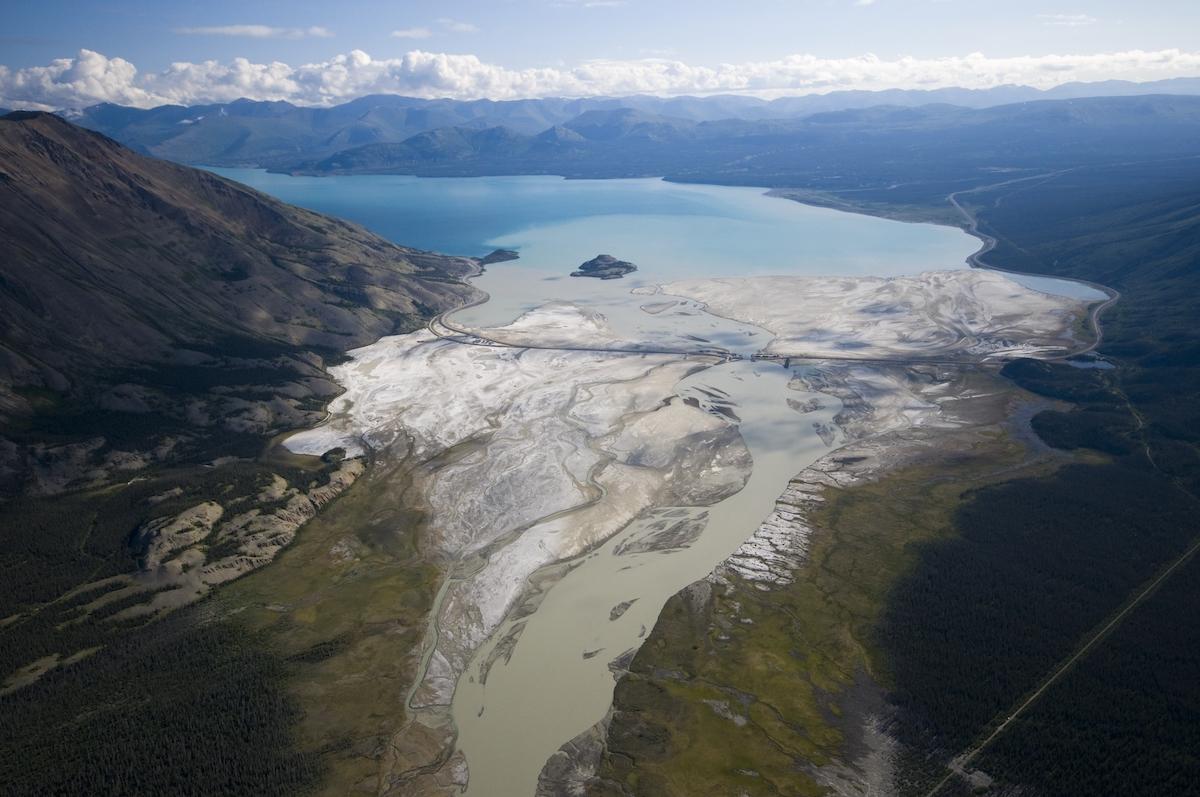
Kluane Lake at the outfall of Ä’äy Chù before the river piracy occurred. Note the island surrounded by water/Travel Yukon
Elders recount stories of a land repeatedly shaped by glaciers. One such story recounts an event less than a hundred years before the Alaska Highway was built. Forty miles south of Ä’äy Chù, a surging Lowell Glacier blocked off the Alsek River and created a 37 mile lake that no longer exists. When the ice dam broke free floodwaters took two Tlingit First Nation camps with it.
The icy blue waters of the 55-mile long Alsek are now a Canadian Heritage River, one of just 40 designated rivers, known for its outstanding natural beauty amongst the icefields and grizzly habitats. Eventually emptying out into the Pacific Ocean, the hillsides leading into the valley still bear the scars from beach ridges created during the five glacial lakes that have formed in the last 3,000 years.
Changes continue along the Alsek River, with recent predictions indicating the river may experience a future case of rerouting once reaching Glacier Bay National Park & Preserve in Alaska.
Forty miles north of the Alsek Valley, in Ä’äy Chù, the changes caused by dramatic glacial movements were still so fresh it was regularly making the news. After reading countless articles about the river piracy, we decided in 2018 to follow the old river bed and see the Kaskawulsh Glacier’s retreat for ourselves.
I was six months pregnant staring into the raging waters of Bullion Creek, one of two feeder creeks on the Ä’äy Chù trail, unloading my bike and blindly trying to gauge if the waters I needed to cross were knee or waist deep. Swollen with the summer melt, the murky water was thick with grey sediment. White caps like fangs crested over what could have been boulders the size of cars.
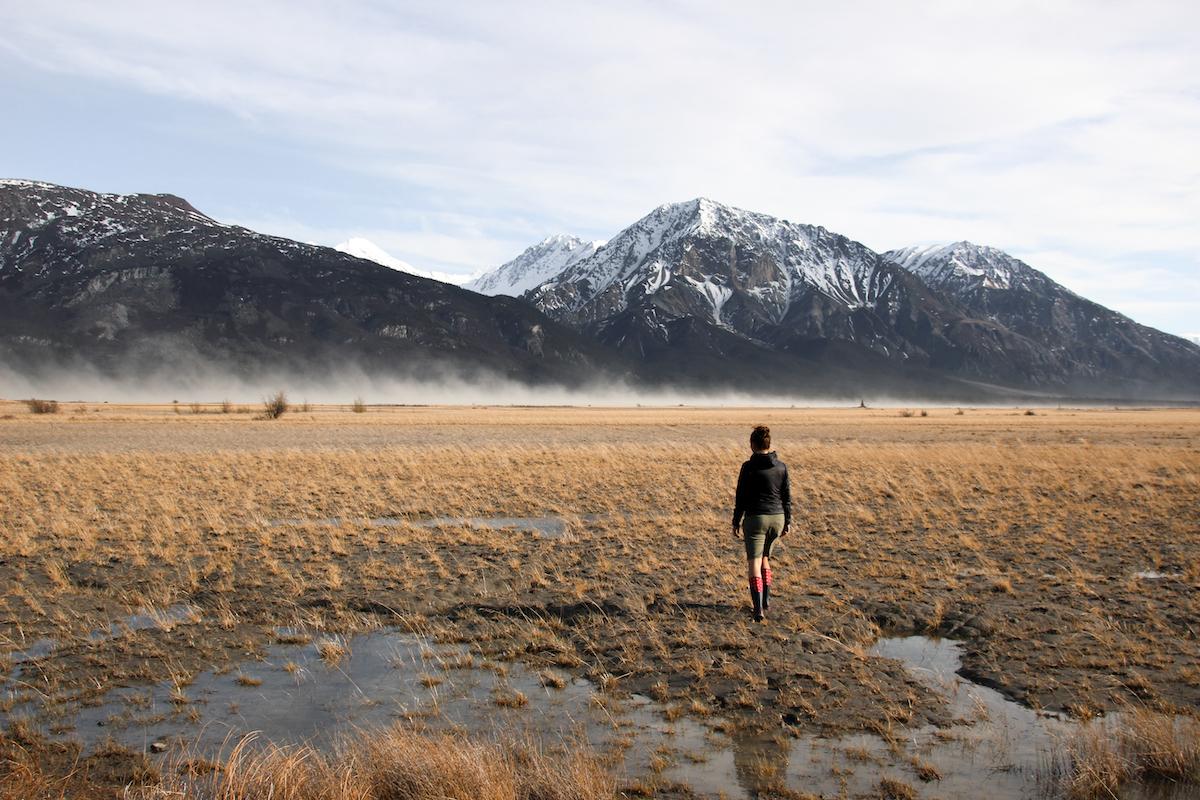
Walking in Kluane/Rachel Bertsch
We were just four of the 696 people registered to do the overnight journey along Ä’äy Chù in 2018. In 2019, only 430 people attempted the same overnight trail, roughly one third of all overnight backcountry users. Just shy of 28 miles roundtrip, it is most commonly accomplished as a hiking trail, however, bikes are permitted.
Our goal was to follow the dried-out floodplain where ’Ä’äy Chù once flowed to the Kaskawulch glacier where the headwaters were. We only had to navigate past two feeder creeks in the process and figured it would take us around four hours to make it to the turnaround point.
We underestimated it.
Despite being a hot summer day in a series of hot days that July, the floodplain was rife with muddy sinkholes and a sandblasting wind so thick with glacial silt, you could taste the dirt. We opted to bike the path closer to the mountains away from those elements. It was eight hours spread over two days riding between sand dunes, trudging through marshlands knee deep in muck, scurrying over alluvial fans and eventually over a hill of stunted spruce before we were setting up our tents in a primitive backcountry campground.
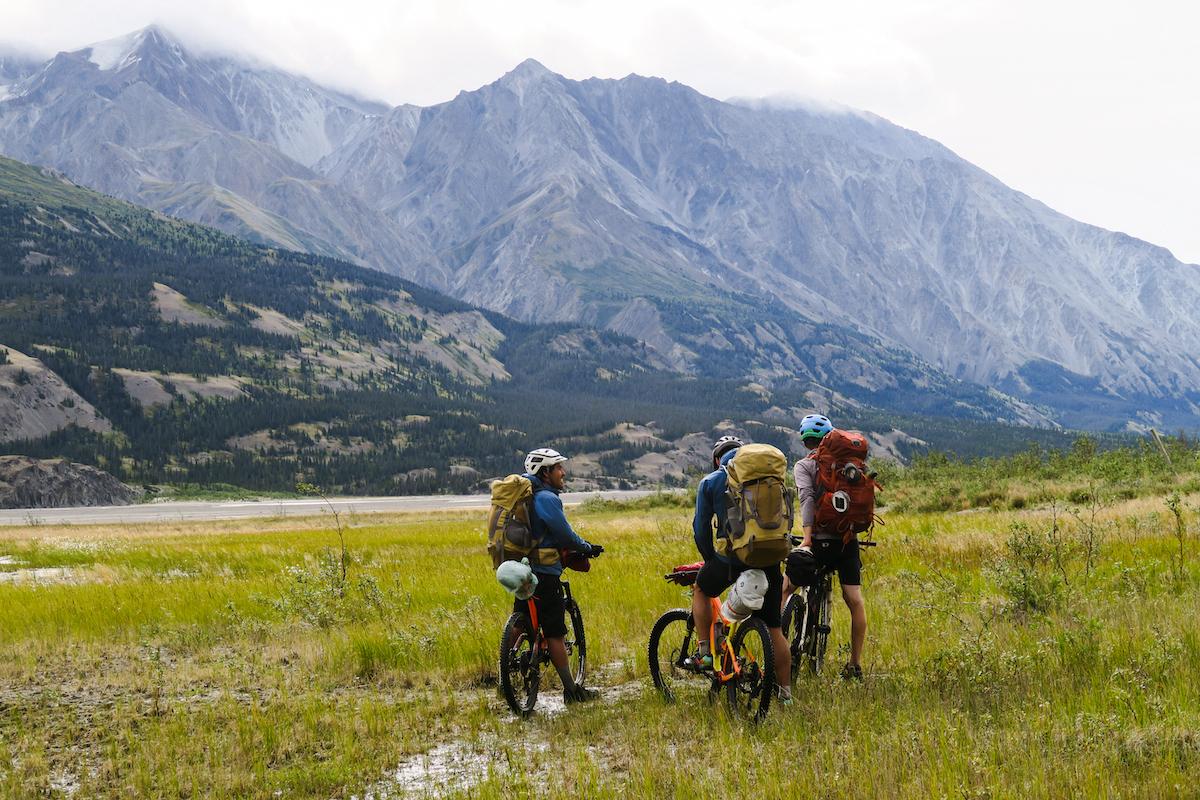
Cycling the Ä’äy Chù marshlands/Rachel Bertsch
We were in the heart of Kluane, and from the mound beside the campground we could finally get a glimpse of the Kaskawulsh Glacier’s toe where the river piracy occurred.
The 75-kilometre long Kaskawulsh looks like a 10-lane highway from above, but from the ground looking up its scale is hard to imagine. We trudged our way there following a faded route adorned with grizzly prints and scat.
According to Carmen Wong, Kluane's ecologist team leader, approximately 160 grizzly bears can be found in the park — “225 if you include transboundary contributions (total bears that use the park).”
Our trip would include a close encounter with one large blonde-coloured bear, too close for our comfort. Thankfully for us, the valley was blanketed with soapberry and bearberry while the creek beds and alluvial fans were full of horsetail and ground squirrels which made us utterly uninteresting to the bear.
Our close encounter was enough for us to retreat to the bustling primitive campground. Adventurers from Germany, America and Yukon pitched tents in the clearings between the spruce and willows. The sun high in the sky until 11:30 p.m. was followed by a twilight that was still bright enough to never need a flashlight. We exited the next morning back down the valley with the winds on our backs propelling us over the muddy riverbed towards the trailhead.
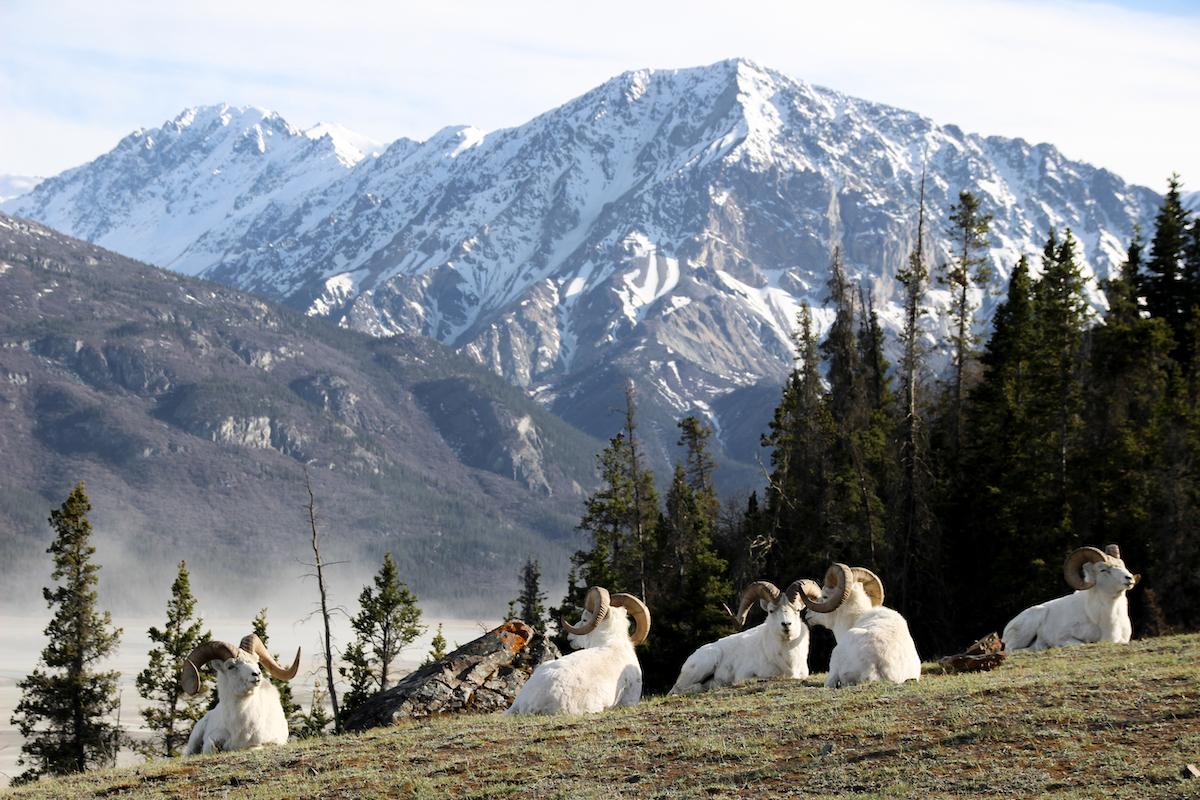
Dall sheep resting above Ä’äy Chù in Kluane/Rachel Bertsch
The trip was one that stuck with me, full of memories that often come with a challenging undertaking in what I’d consider the most scenic trail in Parks Canada’s collection. When our daughter was born, a trip to Kluane was one of our first outings.
Despite being restricted to only a few kilometres from the parking lot, our more recent explorations have been by no means less impressive. In late June, paths lined with purple vetch took us to knolls where Dall sheep rested. By fall, the land becomes ablaze with colour as the willows turn a crimson red and the aspens a crisp yellow. In the winter we have skied the flats, battling the same persistent winds that blow down the glacial valley till our cheeks turned numb.
Year after year, we ponder what changes will occur in this valley in our lifetimes.
Ä’äy Chù is still a trickle, a shadow of its former self but however dramatic the geological and geographical changes are, the effects haven’t been as profound yet for the mammals of the region.
Concerns were brought up at the Kluane Research Summit in 2019 about whether the Dall sheep would be moving off their traditional terrain mountain at the end of the Ä’äy Chù and instead inhabiting the floodplain as the lakeshore became more vegetated, making them more vulnerable to predators. Carmen Wong, the ecologist team lead for Kluane, has spent years studying these sheep and thorough monitoring by parks staff and astute locals say that hasn’t been the case. For the sheep their food is still “found on the grassy slopes of the mountain and not in the alkaline flats.”
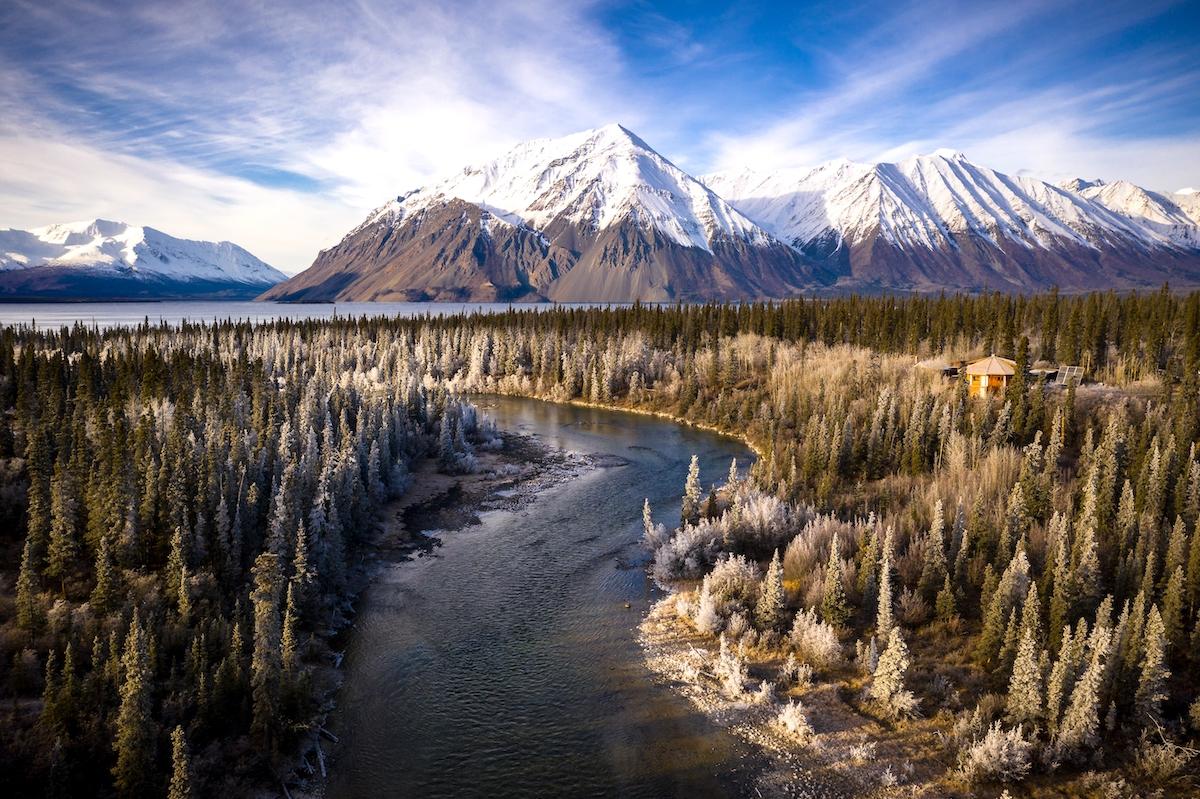
Kathleen Lake in Kluane/Matt Jacques, Travel Yukon
For the grizzlies, Carmen states that there “the river was not an obstacle to bear movement in the past” and is “just less likely now.”
Bears and sheep have continued to thrive on the diversity of vegetation found in a small geographic area. While pondering the effects on plant life, I reached out to Bruce Bennett, the coordinator of Yukon’s Conservation Data Centre who “walked across the flats to the shore of Kluane Lake almost to the day the river piracy occurred.” I asked what changes he had observed.
He recounts how the valley is home to “Yukon’s only population of Seaside Plantain, and perhaps the world’s largest population of Yukon Aster. It also has giant Maritime Sedge which has been described as the yukonensis subspecies. The flats also have a cool creeping willow, Setchell’s Willow which is found around Kluane Lake and its tributaries. It has thick fleshy leaves.”
But as for dramatic changes, only time will tell. Rapid shrubification within Yukon is making areas unrecognizable. Ä’äy Chù will likely suffer that same fate.
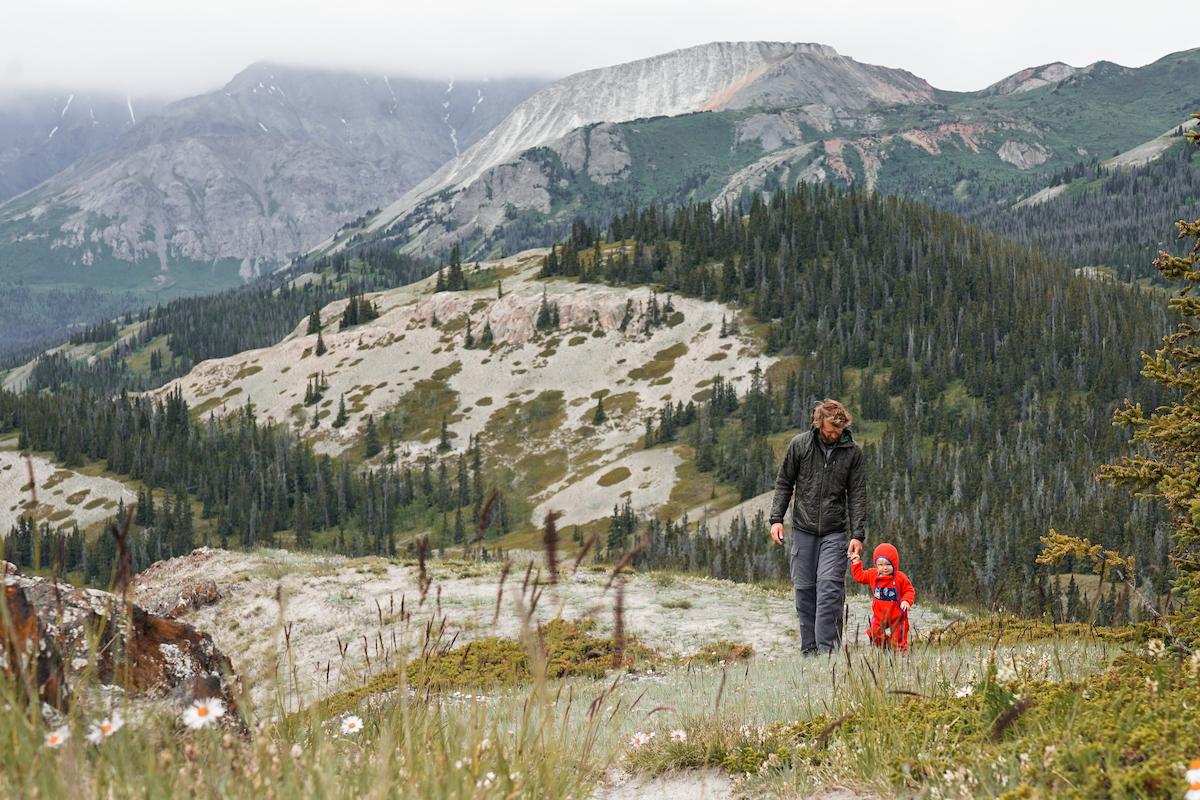
Hiking a knoll in Ä’äy Chù valley/Rachel Bertsch
Luckily Ä’äy Chù is well set up for research with the Kluane Research Station found at the head of the valley, on the shores of the 50-mile long Kluane Lake. It has been a base camp for researchers since 1961 and was home to the researchers to Kluane in 2016 who documented the river piracy.
The station sits on the park boundary where changes are easy to see. In Kluane Lake, which Ä’äy Chù emptied into, lake levels are dropping. Kluane First Nation traditional fishing grounds are getting harder to reach as marinas dry out and boat docks sit above waters too shallow to launch from. In winter, treacherous lake ice forms as natural springs once far below the surface create soft ice that can swallow a snowmachine.
Chum salmon swimming the marathon of the Yukon river and spawning in Kluane Lake now navigate a much shallower tributary to get there. Last year was the worst year on record for chum in Kluane, with approximately 117 fish versus the 16,000-plus estimated in 2017. With numbers that low, it’s hard to gauge what effect the river piracy had on the chum which accounts for 10 per cent of the chum's overall Yukon River population. Lake trout and other northern fish that live in Kluane Lake may see spawning grounds get shallower and warmer, impacts could be devastating.
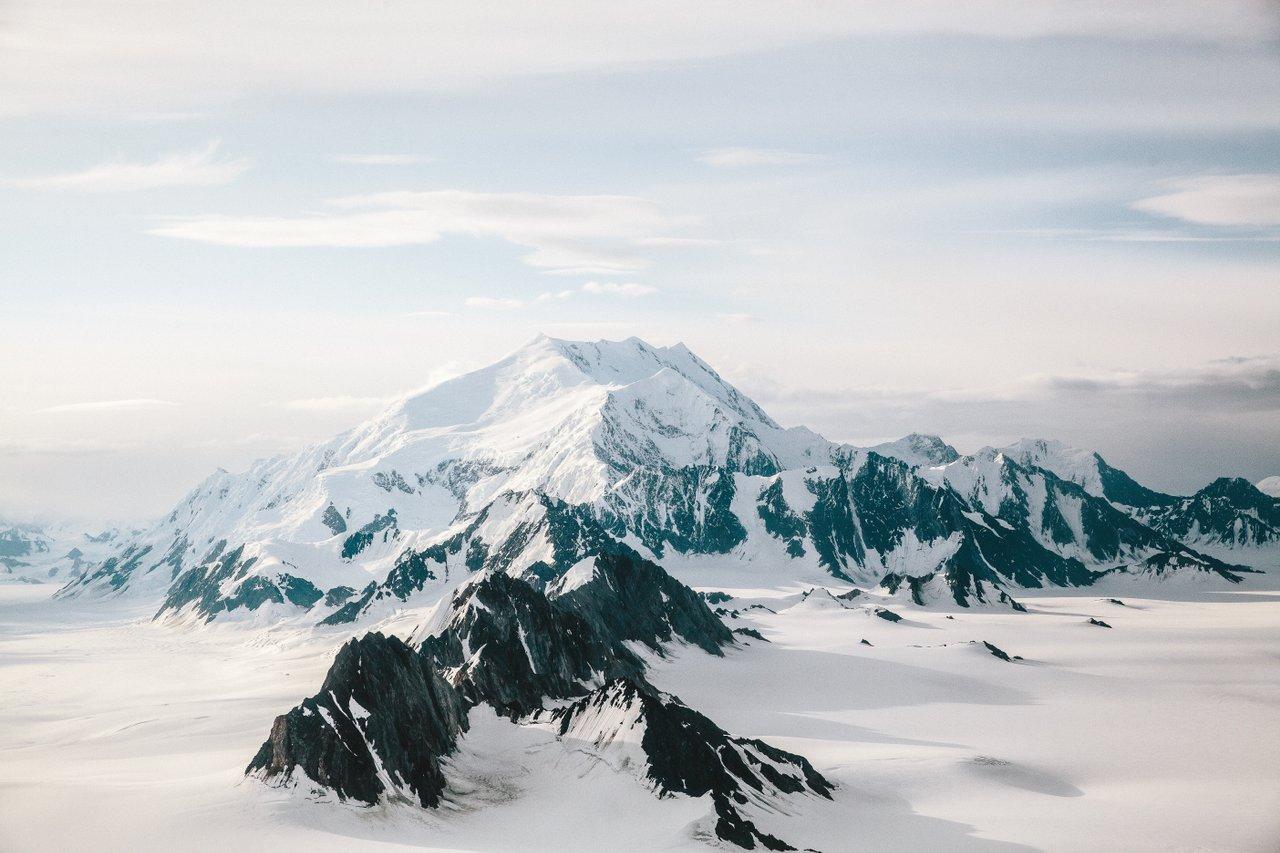
Aerial views of snow-kissed Kluane/Rich Stapleton, Destination Canada
It’s not just the fish that are affected. Sharon Kabanak from Kluane First Nation told journalist Ainslie Cruickshank in 2019 that a piece of land north of Ä’äy Chù used to be filled with ducks. “It was kind of like a duck sanctuary,” she said, “but it’s all dry now.”
We recently visited the park in the spring of 2021, five years after Ä’äy Chù disappeared. Instead of being in a dry valley, we arrived to white out conditions. Winter was still in full force in mid-April, with four inches of snow dropping overnight and the thermometer hovering around minus 30 Fahrenheit. Climate change has warmed Northern Canada’s average annual temperatures by 2.3 degrees Celsius since 1948, but it also has led to more extremes. This year's snowfall was 300 per cent of normal for Southern Yukon. Future years are predicted to get wetter, problematic for a semiarid climate.
With no visibility, we cast our snow bikes aside and decided to walk the flats instead. I watched my daughter stumble over snowdrifts and sink in well past her boots. Beneath the snow was a riverbed with dramatic changes to vegetation, mammals, fish, birds and insects yet to be felt. It will be her generation that bears the brunt of the changes taking place in these mountains. Perhaps her generation will also answer the questions about climate change we have yet to ask or take action in a way we haven’t yet had the courage to try.
After all, change is the only constant we have.
Rachel Bertsch is a Canadian-based travel writer who regularly ventures into the backcountry by canoe, kayak, sailboat, bike, skis or her own two feet. With two young children in tow, she’s out to prove family travel can be anything but boring. Find her at www.meander-the-world.com or @meandertheworld.
Support National Parks Traveler
Your support for the National Parks Traveler comes at a time when news organizations are finding it hard, if not impossible, to stay in business. Traveler's work is vital. For nearly two decades we've provided essential coverage of national parks and protected areas. With the Trump administration’s determination to downsize the federal government, and Interior Secretary Doug Burgum’s approach to public lands focused on energy exploration, it’s clear the Traveler will have much to cover in the months and years ahead. We know of no other news organization that provides such broad coverage of national parks and protected areas on a daily basis. Your support is greatly appreciated.
EIN: 26-2378789
A copy of National Parks Traveler's financial statements may be obtained by sending a stamped, self-addressed envelope to: National Parks Traveler, P.O. Box 980452, Park City, Utah 84098. National Parks Traveler was formed in the state of Utah for the purpose of informing and educating about national parks and protected areas.
Residents of the following states may obtain a copy of our financial and additional information as stated below:
- Florida: A COPY OF THE OFFICIAL REGISTRATION AND FINANCIAL INFORMATION FOR NATIONAL PARKS TRAVELER, (REGISTRATION NO. CH 51659), MAY BE OBTAINED FROM THE DIVISION OF CONSUMER SERVICES BY CALLING 800-435-7352 OR VISITING THEIR WEBSITE. REGISTRATION DOES NOT IMPLY ENDORSEMENT, APPROVAL, OR RECOMMENDATION BY THE STATE.
- Georgia: A full and fair description of the programs and financial statement summary of National Parks Traveler is available upon request at the office and phone number indicated above.
- Maryland: Documents and information submitted under the Maryland Solicitations Act are also available, for the cost of postage and copies, from the Secretary of State, State House, Annapolis, MD 21401 (410-974-5534).
- North Carolina: Financial information about this organization and a copy of its license are available from the State Solicitation Licensing Branch at 888-830-4989 or 919-807-2214. The license is not an endorsement by the State.
- Pennsylvania: The official registration and financial information of National Parks Traveler may be obtained from the Pennsylvania Department of State by calling 800-732-0999. Registration does not imply endorsement.
- Virginia: Financial statements are available from the Virginia Department of Agriculture and Consumer Services, 102 Governor Street, Richmond, Virginia 23219.
- Washington: National Parks Traveler is registered with Washington State’s Charities Program as required by law and additional information is available by calling 800-332-4483 or visiting www.sos.wa.gov/charities, or on file at Charities Division, Office of the Secretary of State, State of Washington, Olympia, WA 98504.
Support National Parks Traveler
Your support for the National Parks Traveler comes at a time when news organizations are finding it hard, if not impossible, to stay in business. Traveler's work is vital. For nearly two decades we've provided essential coverage of national parks and protected areas. With the Trump administration’s determination to downsize the federal government, and Interior Secretary Doug Burgum’s approach to public lands focused on energy exploration, it’s clear the Traveler will have much to cover in the months and years ahead. We know of no other news organization that provides such broad coverage of national parks and protected areas on a daily basis. Your support is greatly appreciated.
EIN: 26-2378789
A copy of National Parks Traveler's financial statements may be obtained by sending a stamped, self-addressed envelope to: National Parks Traveler, P.O. Box 980452, Park City, Utah 84098. National Parks Traveler was formed in the state of Utah for the purpose of informing and educating about national parks and protected areas.
Residents of the following states may obtain a copy of our financial and additional information as stated below:
- Florida: A COPY OF THE OFFICIAL REGISTRATION AND FINANCIAL INFORMATION FOR NATIONAL PARKS TRAVELER, (REGISTRATION NO. CH 51659), MAY BE OBTAINED FROM THE DIVISION OF CONSUMER SERVICES BY CALLING 800-435-7352 OR VISITING THEIR WEBSITE. REGISTRATION DOES NOT IMPLY ENDORSEMENT, APPROVAL, OR RECOMMENDATION BY THE STATE.
- Georgia: A full and fair description of the programs and financial statement summary of National Parks Traveler is available upon request at the office and phone number indicated above.
- Maryland: Documents and information submitted under the Maryland Solicitations Act are also available, for the cost of postage and copies, from the Secretary of State, State House, Annapolis, MD 21401 (410-974-5534).
- North Carolina: Financial information about this organization and a copy of its license are available from the State Solicitation Licensing Branch at 888-830-4989 or 919-807-2214. The license is not an endorsement by the State.
- Pennsylvania: The official registration and financial information of National Parks Traveler may be obtained from the Pennsylvania Department of State by calling 800-732-0999. Registration does not imply endorsement.
- Virginia: Financial statements are available from the Virginia Department of Agriculture and Consumer Services, 102 Governor Street, Richmond, Virginia 23219.
- Washington: National Parks Traveler is registered with Washington State’s Charities Program as required by law and additional information is available by calling 800-332-4483 or visiting www.sos.wa.gov/charities, or on file at Charities Division, Office of the Secretary of State, State of Washington, Olympia, WA 98504.

 Support Essential Coverage of Essential Places
Support Essential Coverage of Essential Places